Ships have a finite lifespan, usually not more than 20 years, often much less. When a ship reaches the end of its economic life, there needs to be a place to recycle the steel, the other valuable metals and equipment. In a perfect world this recycling would be done safely and cleanly. Unfortunately, this is far from a perfect world. Alang beach in India’s Gujarat province is one of the world’s biggest shipbreakers, which the Voice of America calls “an access-restricted, mafia-controlled funerary ground for hulking steel-container vessels marooned for demolition.” The operations are both dirty and dangerous. A 2004 documentary directed by Micheal Kot on the shipbreakers of Alang, India is now available on-line. Disturbing, but worth watching.
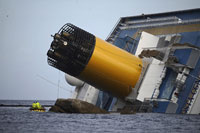
Photo: FILIPPO MONTEFORTE / AFP / GETTY IMAGES
Not long after the Costa Concordia struck Le Scole Rock off the island of Giglio, Italy at 9:45 pm on January 13, 2012, Captain Francesco Schettino’s voice can be heard on a voice-data recording muttering, “Madonna, what a mess I’ve made…”
A 270 page report issued by a team of court appointed experts agrees fully with the captain. The report blames Captain Schettino for action and inaction leading up to and following the collision that resulted in the deaths of 32 passengers and crew on the ill-fated cruise ship. The report also faults the crew and ship owner for a series of blunders, delays and safety breaches that contributed to the disaster.
In addition to causing the grounding by steering far too close to known reefs, the report also charges that the captain delayed issuing the order to abandon ship for almost an hour after the casualty. Rather than issue the abandon ship order at around 10 pm, fifteen minutes after the collision, the order to abandon ship was finally issued at 10:43 pm. When the order was given, it was not given by the captain, as required by regulations, but by a subordinate officer. Captain Schettino also failed to alert port authorities about the accident and left the ship the evacuation of passengers was completed.
 Tomorrow, September 15, a Maritime Ghost Conference will be held on the Steam Ferry Berkeley at the Maritime Museum of San Diego. The conference is sponsored by the San Diego Ghost and Paranormal Group and is also a fundraiser for the Maritime Museum. In addition to presentations by experts on various haunted ships, there will be investigations aboard the windjammer Star of India and the Steam Ferry Berkeley, both of which are said to be haunted.
Tomorrow, September 15, a Maritime Ghost Conference will be held on the Steam Ferry Berkeley at the Maritime Museum of San Diego. The conference is sponsored by the San Diego Ghost and Paranormal Group and is also a fundraiser for the Maritime Museum. In addition to presentations by experts on various haunted ships, there will be investigations aboard the windjammer Star of India and the Steam Ferry Berkeley, both of which are said to be haunted.
If you can’t make the conference here is an episode of Ghost Hunters, courtesy of You Tube, investigating reports of ghosts and the paranormal on the Star of India and the Berkeley.
Continue reading
I have been a fan of Sailor Twain for some time. Sailor Twain, or The Mermaid in the Hudson is a webcomic by Mark Siegel. He has been posting pages online every Monday, Wednesday and Friday, the tale unfolding in the tradition of a 19th century novel. For those of us who haven’t always kept up, the graphic novel is being published in its entirety on October 2, 2012.
Sailor Twain author video from Mark Siegel on Vimeo.
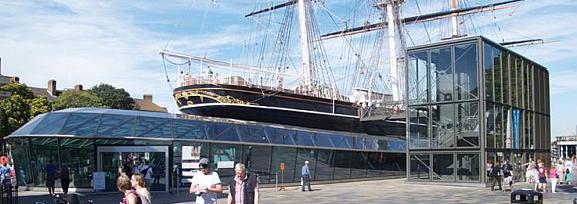 In April, we posted about a scathing review of the Cutty Sark restoration by Andrew Gilligan, the Telegraph‘s London Editor. He referred to the restoration as “a clucking, Grade A … turkey.” I have not seen the ship but I share many of Gilligan’s concerns. (I will be visiting the composite clipper ship in a few weeks when I attend the Historical Novel Society Conference in London, so I will have the opportunity to see for myself.) Mr. Gilligan is not alone in his dislike of the Cutty Sark restoration. The British architectural trade journal, Building Design, has announced that the restoration of the historic tea clipper is the 2012 winner of the Carbuncle Cup for the worst new building design in Britain.
In April, we posted about a scathing review of the Cutty Sark restoration by Andrew Gilligan, the Telegraph‘s London Editor. He referred to the restoration as “a clucking, Grade A … turkey.” I have not seen the ship but I share many of Gilligan’s concerns. (I will be visiting the composite clipper ship in a few weeks when I attend the Historical Novel Society Conference in London, so I will have the opportunity to see for myself.) Mr. Gilligan is not alone in his dislike of the Cutty Sark restoration. The British architectural trade journal, Building Design, has announced that the restoration of the historic tea clipper is the 2012 winner of the Carbuncle Cup for the worst new building design in Britain.
Carbuncle Cup winner 2012: Ship in a throttle
Grimshaw’s disastrously conceived restoration of the Cutty Sark is winner of this year’s BD Carbuncle Cup, tragically defiling the very thing it sets out to save.
On Saturday, a passenger and a crew member on the schooner Bill of Rights were wounded by bird shot apparently fired from the topsail schooner Amazing Grace during a mock sea battle at the Tobisha Tall Ship Festival at Dana Point, CA. Neither the passenger or crew member were seriously injured.
“Battle cruises,” or mock sea battle where tall ships fire their guns at each other are very popular of the tall ship circuit. But where do the ships get their powder? Apparently, in this case at least, from 12 gauge shotgun shells which are fired from their small deck guns. Unfortunately the blank shells, containing powder but without pellets, look quite it a bit like the shells with pellets. The incident is being investigated as an accident.
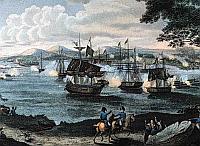
Battle of Plattsburgh
One year and one day after the Battle of Lake Erie, an American squadron, under the command of Master Commandant Thomas Macdonough, defeated the Royal Navy on Lake Champlain in a bloody battle at Plattsburgh Bay. The Battle of Plattsburgh turned back an invasion force of 11,000 British troops which was intended to do nothing less than redraw the map of the United States. Like the Battle of Lake Erie, the Battle of Plattsburg was fought in fresh water hundreds of miles from the ocean. It was not a large fleet battle, and yet, was probably the most important naval victory of the war.
 The best known naval battles of the War of 1812 were single ship duels between US Navy frigates and ships of the Royal Navy. Nevertheless, the two most important American naval victories of the War of 1812 were fought in fresh water, hundreds of miles from the ocean. Neither involved large fleets of ships, yet each was critical to the outcome of the war.
The best known naval battles of the War of 1812 were single ship duels between US Navy frigates and ships of the Royal Navy. Nevertheless, the two most important American naval victories of the War of 1812 were fought in fresh water, hundreds of miles from the ocean. Neither involved large fleets of ships, yet each was critical to the outcome of the war.
One hundred and ninety nine years ago today, on September 10, 1813, in what has become known as the Battle of Lake Erie, five schooners, three brigs and a sloop, under the command of Oliver Hazard Perry defeated and captured two ships, two schooners, a brig and a sloop of the Royal Navy at Put-in-Bay in Lake Erie off the coast of Ohio. The victory gave the Americans control of Lake Erie for the rest of the war, denying the British and Canadians a key supply line and allowing the Americans to retake Detroit and win the Battle of the Thames to break the Indian confederation of Tecumseh.
A commemoration of the 199th anniversary of the Battle of Lake Erie is being held today at 5:30 PM at the Perry monument at Presque Isle State Park in Pennsylvania.
 Shackleton Epic Expeditions has announced the availability of 10 berths on T/S Pelican when it serves as a support vessel for the upcoming re-enactment of an epic lifeboat voyage undertaken by Ernest Shackleton and five sailors in 1916. The Pelican is a 148ft long three-masted barquentine. See our previous post for a video of the Pelican under sail in the Thamse Estuary at the Queen’s Diamond Jubilee last May.
Shackleton Epic Expeditions has announced the availability of 10 berths on T/S Pelican when it serves as a support vessel for the upcoming re-enactment of an epic lifeboat voyage undertaken by Ernest Shackleton and five sailors in 1916. The Pelican is a 148ft long three-masted barquentine. See our previous post for a video of the Pelican under sail in the Thamse Estuary at the Queen’s Diamond Jubilee last May.
 Good news. On Friday, we posted that the captain of the U.S. flag heavy lift ship, MV Ocean Atlas, had been arrested in Maracaibo, Venezuela after three rifles were found aboard the ship. The rifles had reportedly been listed in the ship’s manifest. Reports are that Venezuelan authorities had raided the ship, acting on a tip that illegal drugs were onboard. When no drugs were found, Captain Jeffrey Raider was arrested for arms trafficking based on the three locked-away rifles. There were reports that the rest of the 14 man crew would also be charged. A U.S. State Department official confirmed Sunday that the charges had been dropped. The ship is expected to sail today or tomorrow.
Good news. On Friday, we posted that the captain of the U.S. flag heavy lift ship, MV Ocean Atlas, had been arrested in Maracaibo, Venezuela after three rifles were found aboard the ship. The rifles had reportedly been listed in the ship’s manifest. Reports are that Venezuelan authorities had raided the ship, acting on a tip that illegal drugs were onboard. When no drugs were found, Captain Jeffrey Raider was arrested for arms trafficking based on the three locked-away rifles. There were reports that the rest of the 14 man crew would also be charged. A U.S. State Department official confirmed Sunday that the charges had been dropped. The ship is expected to sail today or tomorrow.
The M/V Ocean Atlas is an 8,000 DWT multipurpose ship with a 400 tonne lifting capacity. One of four heavy-lift vessels of Intermarine’s U.S.-flag heavy-lift affiliate, U.S. Ocean, the ship is operated by Crowley.
Venezuela drops arms trafficking charges against U.S. ship crew
The 4,380 TEU container ship Amsterdam Bridge caught fire on a voyage between Mumbai to Colombo. The ship returned to Mumbai and is now at an outer anchorage. Recent reports suggests that the fire is contained if not necessarily completely extinguished. VesselTracker.com is reporting that Coast Guard officials suspect that the fire erupted in the engine room of the vessel. Other sources say that the fire spread to the mid portion of the ship, which is said to be carrying approximately 112 containers loaded with hazardous cargoes. No injuries have been recorded. Thanks to Phil Leon for passing along the news. (Note: the original post misstated the container capacity of the ship. Thanks to Terra for pointing out the error.)
In related news, the container ship MSC Flaminia, which caught fire and was abandoned in the mid-Atlantic on July 14th, has finally arrived at the German port of Wilhelmshaven.
From the “Muppets Treasure Island” 1996.
Thanks to Cynthia Drew for daring me to post it.
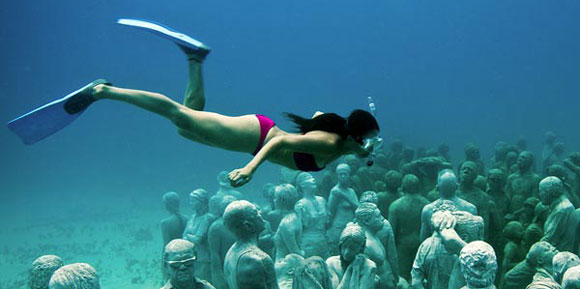 Snorkelers and divers swimming south of Isla Mujeres and off Punta Nizuc off Cancun will now find themselves in a monumental underwater sculpture garden of life-sized human statues rising up from the sandy bottom in crystal tropical clear waters. The 450 sculptures are the work of British artist Jason deCaires Taylor and are part of MUSA (Museo Subacuático de Arte,) a vast underwater museum in the in the waters surrounding Cancun, Isla Mujeres and Punta Nizuc.
Snorkelers and divers swimming south of Isla Mujeres and off Punta Nizuc off Cancun will now find themselves in a monumental underwater sculpture garden of life-sized human statues rising up from the sandy bottom in crystal tropical clear waters. The 450 sculptures are the work of British artist Jason deCaires Taylor and are part of MUSA (Museo Subacuático de Arte,) a vast underwater museum in the in the waters surrounding Cancun, Isla Mujeres and Punta Nizuc.
The Great Mayan Reef is the second largest barrier reef in the world. In addition to being threatened by pollution, over-fishing and ocean warming, the reef is also threatened by its popularity. The section of the reef adjacent to the resort islands of Cancun and Isla Mujeres attracts 750,000 people each year. One of the stated objective of the museum is to take pressure off the natural reef by drawing visitors to the sculpture reef.
The plan for a new artificial reef was wonderful, and beautifully executed until the very last minute. Artist Chris Wojcik had constructed a 47-foot-long, 25,000-pound concrete sculpture of a horseshoe crab, which was welded to two barges and was to be sunk in the Atlantic off the New Jersey shore as a new artificial reef, providing both a new habitat for sea life and a destination for recreational divers. The project was dubbed “Art as Reef.” (See our previous post here.)
The crab sculpture was towed out to the reef site in the Atlantic on Axel Carlson Reef, in 80 feet of water, 4.4 miles from the Manasquan Inlet.. The plan was to flood the barges while stabilizing them with straps from a crane barge to ensure that the barges sank on an even keel. Everything went well until the after crane strap broke. Instead of a level sinking, the barge dove unexpectedly, cracking and crushing the concrete sculpture. As reported by the Asbury Park Press: “It’s cut in pieces and unrecognizable,” artist Chris Wojcik said early Friday morning, after making dives Thursday on the artificial reef structure intended to be the sculpture’s home. “I’m devastated, is a pretty accurate way to put it,” Wojcik said.
While it may not be the work of art intended, the broken crab and barge will still serve as an artificial reef, providing an new habitat for marine life.

Armstrong from 1969
Neil Armstrong, the first man to set foot on the moon, best known for navigating the Sea of Tranquility, began his career as a Navy aviator. Armstrong, who died on August 25, at the age of 82, will be buried at sea as per his wishes. NASA has scheduled a public memorial service to be held Sept. 13 at Washington National Cathedral. No date has been set for the burial at sea which will be performed by the US Navy.
Neil Armstrong, who stood on moon’s Sea of Tranquility, to be buried at sea

Photo: Intermarine
On August 29, the multipurpose US flag cargo ship, M/V Ocean Atlas, arrived in Maracaibo, Venezuela. Not long after, the ship was detained by Venezuelan security forces and was repeatedly searched by agents from Interpol and the Venezuelan drug enforcement agency, reportedly based on a tip that illegal drugs were being carried aboard the ship. When no drugs were apparently found, the Venezuelan authorities arrested the captain of the ship on charges of arms trafficking, after finding three rifles on board. The rifles were apparently listed in the ship’s manifest. The US crew were initially detained aboard, though there are reports that warrants have been issued for their arrest as well and that some or all have been taken ashore for questioning.
 Sad news. Dr. Edmund ‘Ned’ Cabot, 69, a retired surgeon and a lifelong sailor, drowned on Saturday off the coast of Newfoundland when his sloop Cielita was knocked down by a “rogue wave” and he was lost overboard.
Sad news. Dr. Edmund ‘Ned’ Cabot, 69, a retired surgeon and a lifelong sailor, drowned on Saturday off the coast of Newfoundland when his sloop Cielita was knocked down by a “rogue wave” and he was lost overboard.
Edmund ‘Ned’ Cabot, Boston Brahmin scion and avid yachtsman, drowns off Newfoundland
Cabot and his two friends set out along the Newfoundland coast in winds that neared gale force Saturday morning, Ellis said, and the winds increased during the day. Ellis said that from what he understood, around midday, with winds coming from the rear of the boat from about a 45-degree angle, Cabot came from below deck to relieve the helmsman. A wave struck with such force that the boat was knocked on its side, spilling Cabot and the helmsman into the water.
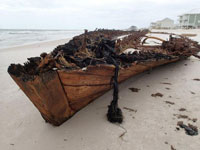
Schooner Rachel makes another appearance Photo: MEYER VACATION RENTALS
The first reports spoke of a “mystery shipwreck” uncovered by Hurricane Isaac on an Alabama beach about six miles from Fort Morgan. It turns out the wooden vessel is not so mysterious after all. Local historians identified her as the 150 feet long, three masted, lumber schooner Rachel built in 1918, which came ashore in a storm in 1923. This is not even the first time that the wreck has made an appearance. She was also uncovered from beneath the beach by Hurricane Camille in 1969, then again in 2004 after Hurricane Ivan, and again in 2008 after Hurricane Ike. The only thing mysterious about the schooner is her cargo on the night of her demise. Legend has it that she was carrying bootleg alcohol instead of lumber when she ran aground during the Prohibition.
The sea ice in the Arctic has melted to a record low this year. Yachts are not voyaging where once only large icebreakers could travel. Recently, the three man crew of the Belzebub II, a 1976 built Hallberg-Rassy Monsun 31 sloop, successfully completed a three month transit of the fabled Canadian Northwest Passage, including becoming the first sailboat to cross the infamous M’Clure strait, which normally would be icebound. From the expedition web site:

Photo: Belzebub II crew
“The Arctic is melting at an alarming rate and is clear proof of our disharmony with the planet. By sailing this newly opened route we hope that our expedition will play a small part in bringing further attention to climate change and contributing to a larger shift in attitudes. Our approach to sail across a historical stretch of water that has traditionally been frozen is meant to be a clear visual example of the extent of declining polar ice.”

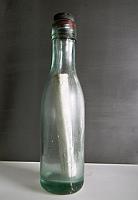 Last year around this time, we posted about
Last year around this time, we posted about